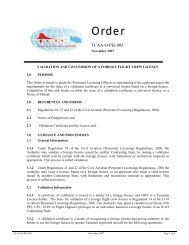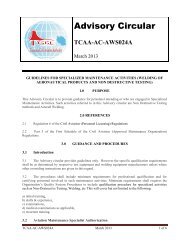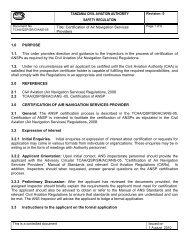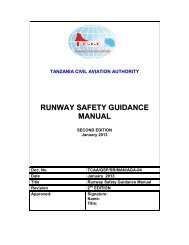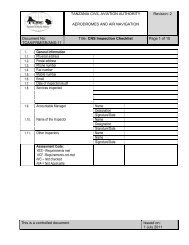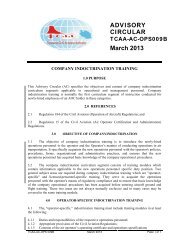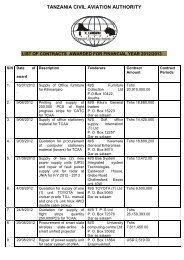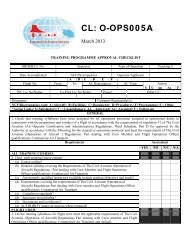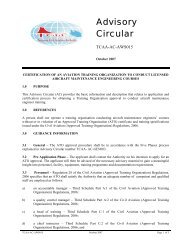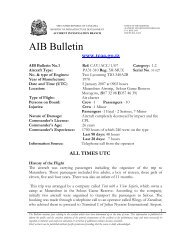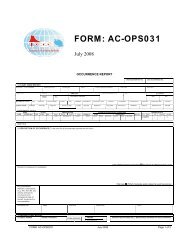Minimum Equipment List - Tanzania Civil Aviation Authority
Minimum Equipment List - Tanzania Civil Aviation Authority
Minimum Equipment List - Tanzania Civil Aviation Authority
- No tags were found...
Create successful ePaper yourself
Turn your PDF publications into a flip-book with our unique Google optimized e-Paper software.
ADVISORYCIRCULARTCAA-AC-OPS 030AJuly 2008MINIMUM EQUIPMENT LIST (MEL)1.0 PURPOSEThis Advisory Circular ( AC) is to provide guidance to operators for the development of a<strong>Minimum</strong> <strong>Equipment</strong> <strong>List</strong> (MEL).2.0 REFERENCERegulation 38 of the <strong>Civil</strong> <strong>Aviation</strong> (Air Operator Certification and Administration) Regulations3.0 GENERAL3.1 Regulation 38 of the <strong>Civil</strong> <strong>Aviation</strong> (Air Operator Certification and Administration)Regulations requires that an operator provides a MEL, for a specific aircraft type and variant theminimum operable equipment required, taking into account operating rules for the existingenvironmental conditions for the commencement and continuance of flight. Aircraft may also beapproved for operations with missing secondary airframe and engine parts. Approval foroperating with these parts missing would be authorised by the State of aircraft design. Evaluationand approval of Configuration Deviation <strong>List</strong> (CDL) are functions of the State of aircraft design.3.2 Each operator is required to produce an MEL appropriate to his own routes andprocedures within the limitations defined by the Master <strong>Minimum</strong> <strong>Equipment</strong> <strong>List</strong> (MMEL) forthe aircraft.4.0 MASTER MINIMUM EQUIPMENT LIST4.1 In conjunction with the certification of each new transport type aircraft, a Board isnormally established by the certifying State to develop and maintain an MMEL for the aircraftand additional models of that aircraft developed in the future. The Board is an advisory body tothe <strong>Authority</strong> of the certifying State with representation from the flight operations andairworthiness organisations within the <strong>Authority</strong>, as well as from the organisation responsible forthe type design and the initial operators of the aircraft.4.2 The development of the MMEL requires detailed analysis and careful safety assessment.The interaction between systems needs to be fully analysed to ensure that multiple failures willnot result in an unsatisfactory level of safety. When an aircraft is designed it is designed toachieve a certain level of safety. When any one system, instrument or equipment becomesinoperative, the design level of safety is reduced. With modern aircraft it is usual to provide extraredundancy in some systems to enable the aircraft to take off and complete a flight withacceptable margins of safety even if, for example, one channel of a system has failed during aprevious flight. Minor deficiencies, even without the provision of extra redundancy, which do nottoo seriously affect safety, may be acceptable for an occasional flight. In any case, the MMELTCAA-AC-OPS 030A July 2008 Page 1 of 3
oard would need to carry out a thorough safety assessment as a guide to developing anacceptable list.4.3 The MMEL would not include obviously required items such as wings, empennage,flaps, power plants, etc., nor would it include items which do not affect the airworthiness of theaircraft, such as galley equipment, entertainment systems, etc. It must be emphasized andunderstood that all items which are related to the airworthiness of the aircraft and are not includedon the MMEL are automatically required to be operative.4.4 The actual format of the MMEL may vary, but all major systems would be listed toindicate they have been considered (communications systems, navigation syst ems, automaticflight control systems, etc.). In addition, those components of a system required for flight orcertification would be listed on the MMEL (e.g. attitude gyros, VSI, DME, etc.).4.5 The MMEL board is responsible for maintaining an up-to-date MMEL. Amendmentnormally results from operator experience or analyses carried out by the organization responsiblefor the type design.4.6 The current MMEL for a given aircraft would normally be obtained from theorganization responsible for the type design of the aircraft or from the civil aviation authority ofthe certifying State.5.0 OPERATOR MINIMUM EQUIPMENT LIST5.1 A minimum equipment list, approved by the <strong>Authority</strong>, is required for each aircraft,based on the MMEL established for the aircraft type by the organization responsible for the typedesign in conjunction with the State of Design. An operator is required to produce his own MELbased on the MMEL for the type and variant of aircraft. The operator’s MEL is submitted to the<strong>Authority</strong> for approval. The approved MEL must be made available for the use and guidance offlight and ground operations personnel. The MEL should be tailored to the individual operator’sroutes and procedures within the constraints imposed by the MMEL. The MMEL is not part ofthe required aircraft documentation but it is necessary for an operator to request a copy of thecurrent MMEL and amendments as they occur, in order to develop and maintain an MEL forapproval by the <strong>Authority</strong>.5.2 In developing an MEL, the philosophy should be to authorize continuation of flight withinoperative equipment only when the inoperative equipment does not render the aircraftunairworthy for the particular flight. Limitations, procedures and substitutions may be used toprovide conditions under which the inoperative equipment will not make the operation unsafe orthe aircraft unairworthy. This is not a philosophy which permits reduced safety in order to fly to abase where repairs can be made, but rather a philosophy which permits safe operations for a takeofffrom a maintenance base or an en-route stop. It is emphasized that the operator will need toexercise close operational control over the use of the MEL by all concerned.5.3 Regulation 10 of the <strong>Civil</strong> <strong>Aviation</strong> (Operation of Aircraft) Regulations requires that anAir Operator carries an MEL on board. This may be part of his operations manual or a separatedocument. The MEL must cover requirements and procedures for dispatch with unserviceableequipment.6.0 OPERATOR RESPONSIBILITIES|6.1 An operator is responsible for exercising the necessary operational control to ensure thathis aircraft are not dispatched with multiple MEL items inoperative without first determining thatany interface or interrelationship between the inoperative systems or components will not resultin degradation in the level of safety or an undue increase in crew workload.TCAA-AC-OPS 030A July 2008 Page 2 of 3
6.2 The MEL is not intended to provide for continued operation of the aircraft for extendedperiods exceeding the time limitations as permitted by the MEL. MEL items should be repairedwithin the allotted A, B, C or D category time limits.6.3 The exposure to additional failures during continued operation with inoperative systemsor equipment must also be considered in determining that an acceptable level of safety is beingmaintained. The MEL is not allowed to deviate from requirements of the flight manual limitationssection, emergency procedures or other airworthiness requirements of the State of Registry or ofthe <strong>Authority</strong> unless the appropriate airworthiness authority or the flight manual providesotherwise.6.4 Systems or equipment accepted as inoperative for a flight should be placarded whereappropriate and all such items shall be noted in the aircraft technical log to inform the flight crewand maintenance personnel of the inoperative system or equipment.6.5 For a particular system or item of equipment to be accepted as inoperative, it may benecessary to establish a maintenance procedure, for completion prior to flight, to deactivate orisolate the system or equipment. It may similarly be necessary to prepare an appropriate flightcrew operating procedure.6.6 Regulation 43 of the <strong>Civil</strong> <strong>Aviation</strong> (Operation of Aircraft) Regulations requires the PICto be responsible for the safe operation of an aircraft. Therefore the PIC shall decide whether ornot to accept an aircraft with unserviceable equipment as permitted by the (CDL) or MEL.___________________________<strong>Tanzania</strong> <strong>Civil</strong> <strong>Aviation</strong> <strong>Authority</strong>TCAA-AC-OPS 030A July 2008 Page 3 of 3



